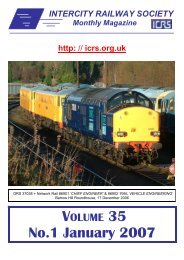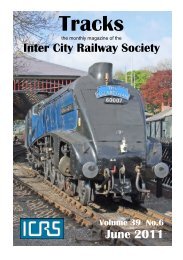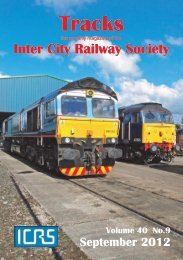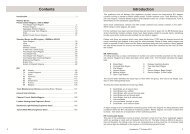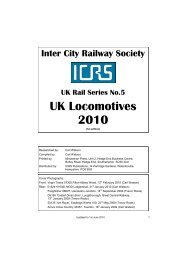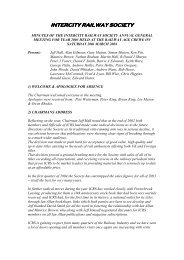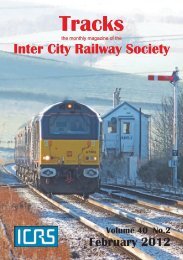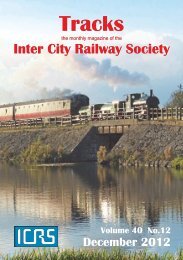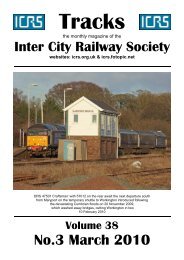September - Intercity Railway Society
September - Intercity Railway Society
September - Intercity Railway Society
You also want an ePaper? Increase the reach of your titles
YUMPU automatically turns print PDFs into web optimized ePapers that Google loves.
Fleet Liveries – Post Privatisation<br />
East Coast HSTs, Cl.91s & DVTs<br />
Potted History of the Route: One of two main north / south arterial routes, the east coast route<br />
(ECML) from King’s Cross to Edinburgh and Aberdeen is associated with one named train, Flying<br />
Scotsman. This famous name has and still is used to market the whole route. The ECML has always<br />
been associated with speed records and prestigious trains including streamlined Gresley 4-6-2 A4s,<br />
‘Mallard’ being the most famous which still hold the world steam record at 126mph. Steam then gave<br />
way to the equally admired Cl.55 Deltics in the late 1960s with their distinctive Napier engines. In the<br />
late 1970s these too succumbed to progress and the ECML received a batch of the new HSTs. Again<br />
a world record is still officially held by a HST on the ECML of 148mph for a diesel loco. Though the<br />
ECML was always a high speed route the first section to be raised to 100mph wasn’t until 1965. The<br />
ECML was electrified later than the west coast route (WCML), during the late 1980s, the full scheme<br />
coming into operation in 1990. With the re-engineered high speed route came new stock under the<br />
banner of InterCity 225. On the same principle as the HSTs these were push-pull sets of Cl.91<br />
electrics, Mk.4 coaches (unique to the ECML) and DVTs. These were built to run at 140mph but have<br />
been prevented from doing so by various operating restrictions. This situation may change with<br />
proposals to raise the line speed under the <strong>Intercity</strong> Express Programme to replace HSTs....that’s<br />
another ongoing story!!<br />
a good example of corporate image seen here with uniform liveried GNER Cl.91s and HSTs<br />
91107, 91124, 91111, 91101, 43102 & 43069, King’s Cross, 27 March 2007<br />
note the different light clusters on the two HSTs<br />
HSTs / IC125: The first incarnation of high speed trains were given the brand InterCity125 and are<br />
capable of running at 125mph, making them the fastest diesel locos in the world in regular service.<br />
HSTs were originally classified as Cl.254 multiple units, the thought being they would remain in fixed<br />
formations, with two Cl.43 power cars at either end of a set of Mk.3 coaches, similar to loco hauled<br />
coaches but without buffers. As stated above the ECML HSTs started regular service from 1977 and<br />
within 2 years had displaced the Deltics. The ECML numbering of HSTs was 254xxx but as power<br />
cars were interchanged amongst sets the set designation failed resulting in identification reverted to<br />
the individual power cars. Through the 1980s, HSTs were the main traction on the ECML until<br />
completion of electrification. When the Cl.91s entered service, many HSTs were cascaded to other<br />
routes, leaving a core of, I believe, 13 sets into privatisation with 32 power cars, later reduced to 30<br />
power cars. These were still needed for non-electrified routes north of Edinburgh to Aberdeen and<br />
Inverness. Between 2007-09 following a similar programme for the FGW HSTs the original Paxman<br />
8



